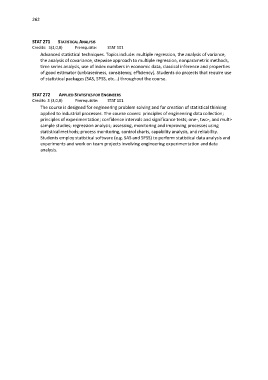Page 263 - University Bulletin
P. 263
TRN334 Simultaneous Interpreting I
Credits: 3 (3,0,0) Prerequisites: TRN333
This course is designed to lay the foundation for developing the basic skills and strategies of
simultaneous interpreting. Students are introduced to the context of simultaneous interpreting
and the nature of the underlying transfer process, the tools and equipment used, the code of
practice, the customer and booth etiquette. Working with their language pair, they will be taught
how to apply the different techniques used in simultaneous interpreting, identify problems likely
to arise in this particular mode of interpreting and solve them using appropriate interpreting
strategies and procedures. Students will develop skills specific to simultaneous interpreting of real
speeches used in different fields.
TRN335 Public Service Interpreting
Credits: 3 (3,0,0) Prerequisites: TRN231
This course introduces students to Public Service Interpreting both in preparation for further
learning and training on other interpreting modes, and for readiness to work in employments
requiring language mediation between interlocutors in offices and public service circles such as
hospitals and other health facilities, law firms and institutions, and tourism and hospitality.
Students will be trained on skills and techniques as appropriate to Public Service Interpreting, in
and out of their two working languages –Arabic and English, in particular active listening to and
fast oral delivery of messages transmitted between interlocutors.
TRN342 Audiovisual Translation
Credits: 3 (3,0,0) Prerequisites: TRN241
The increased availability of audiovisual content due to social media platforms like YouTube, and
the crossing of cultural domains by companies such as Netflix has increased the need for subtitling.
To reflect the growing demand for audiovisual translators, this course aims to endow students
with the conceptual understanding of subtitling and the technical skills to produce subtitles for
diverse content. To accomplish this, students will be taught how to use Aegisub, which is an open-
source subtitle editing application that can produce high quality material. In addition, the course
will cover various approaches to produce and critically evaluate subtitles for a range of genres
from comedy to documentaries.
TRN343 Machine Translation
Credits: 3 (3,0,0) Prerequisites: TRN241
Since its early origins in the 1950s, Machine Translation (MT) has conceptually had the potential
to radically alter human communication, and in this regard, the course will engage with the history
and social relevance of MT. Also, the course will endow students with the knowledge of the
different types of MT, and describe the sectors that MT is most applicable. In addition, the course
will teach students the practical skills needed to use MT in the realm of professional translation,
which includes pre- and post-editing tasks. Students will learn how to post-edit with an open-
source application, MateCat, and with a professional CAT tool that integrates MT. Furthermore,
students will be introduced to the application of MT to second language learning.
TRN424 Legal and Political Translation
Credits: 3 (3,0,0) Prerequisites: TRN110
This course promotes students’ skills in translating legal and political texts burdened with the
complexity of structure and terminology. The essential elements of legal and political writing
styles are introduced for this type of formal translation work. Text types such as court decisions,
contracts, and notary deeds are dealt with. On the political side, students translate text types such
as editorial articles, speeches, diplomatic and international organizations' documents.
251 PSU UNDERGRADUATE BULLETIN

